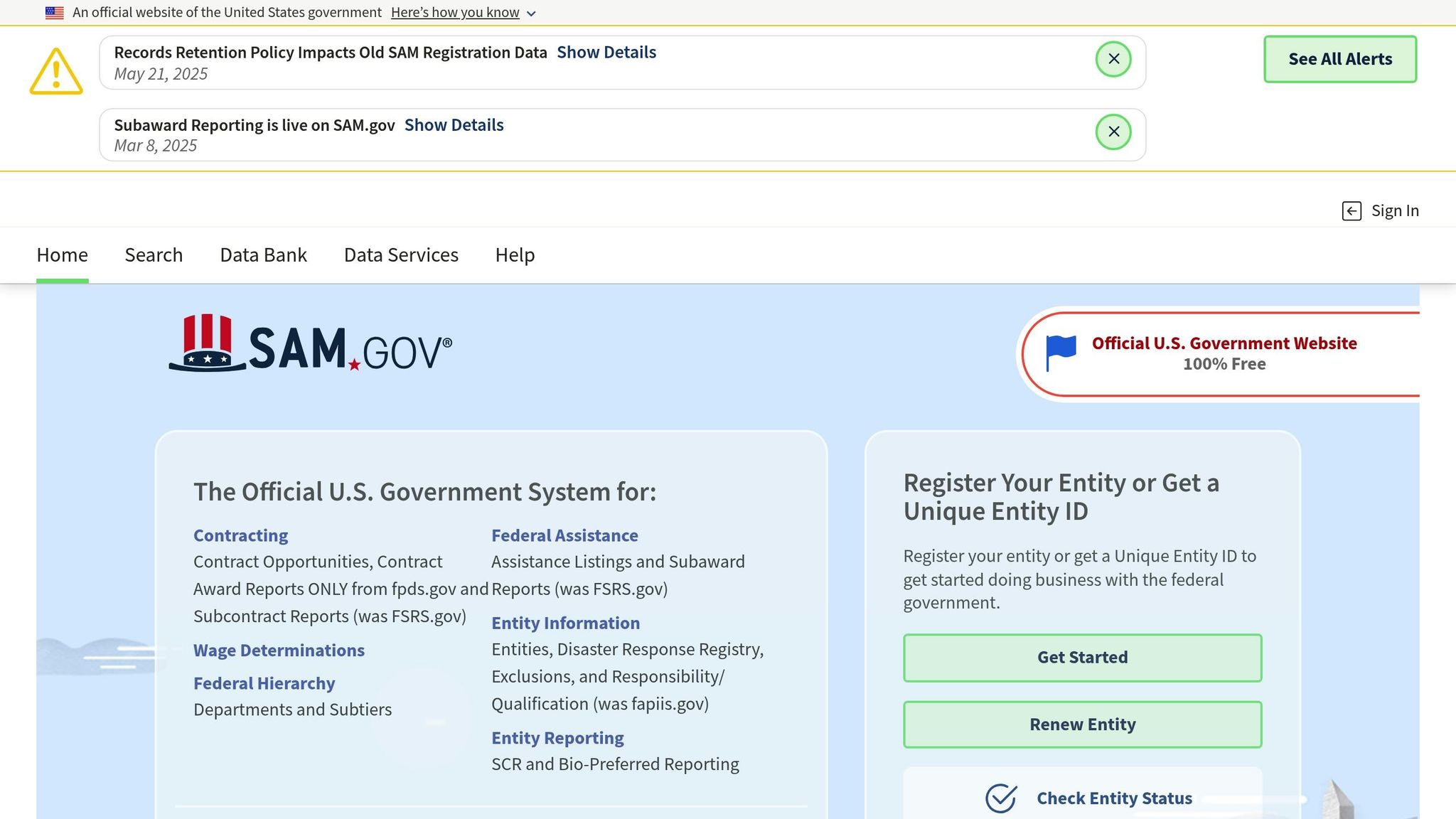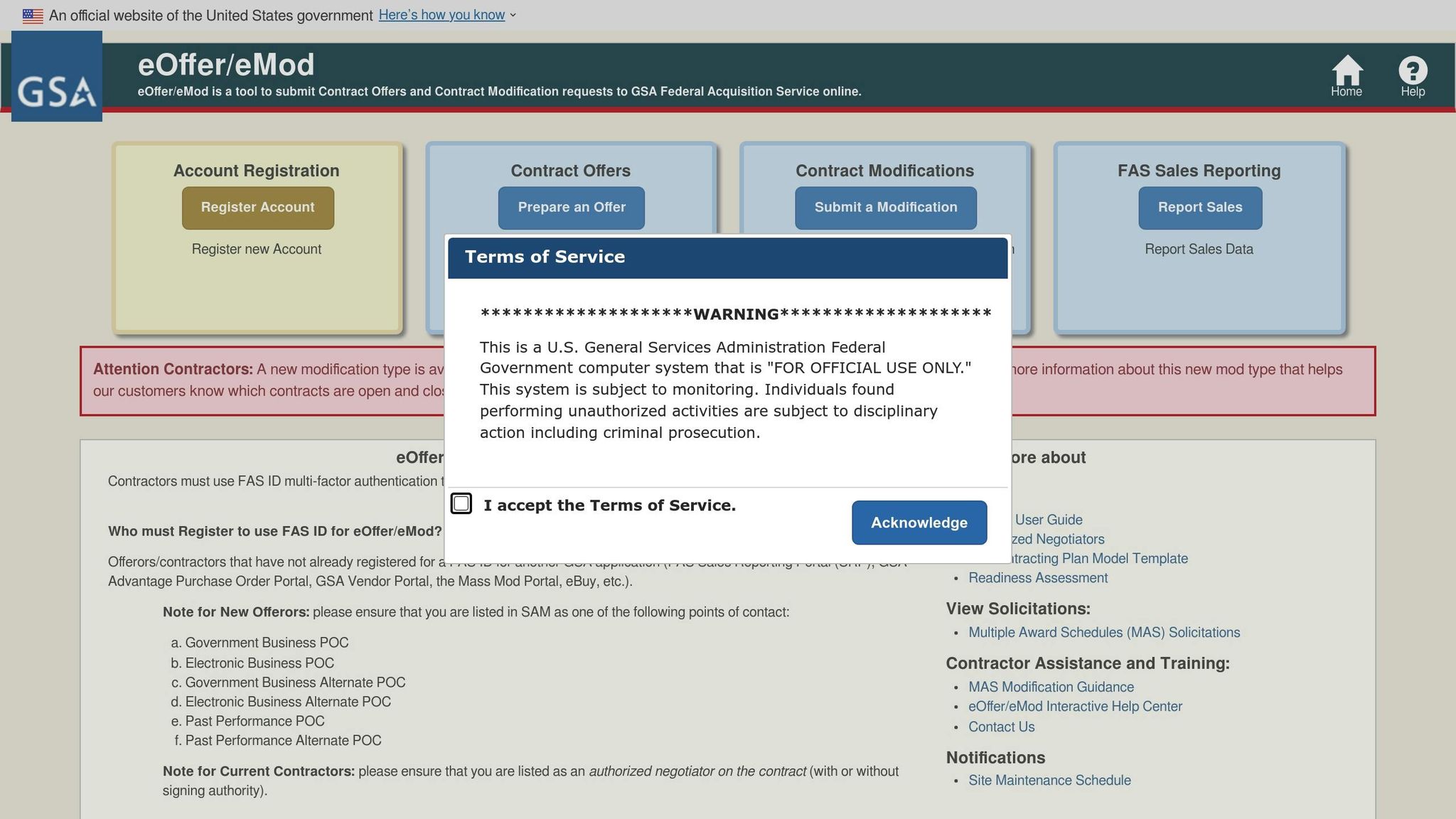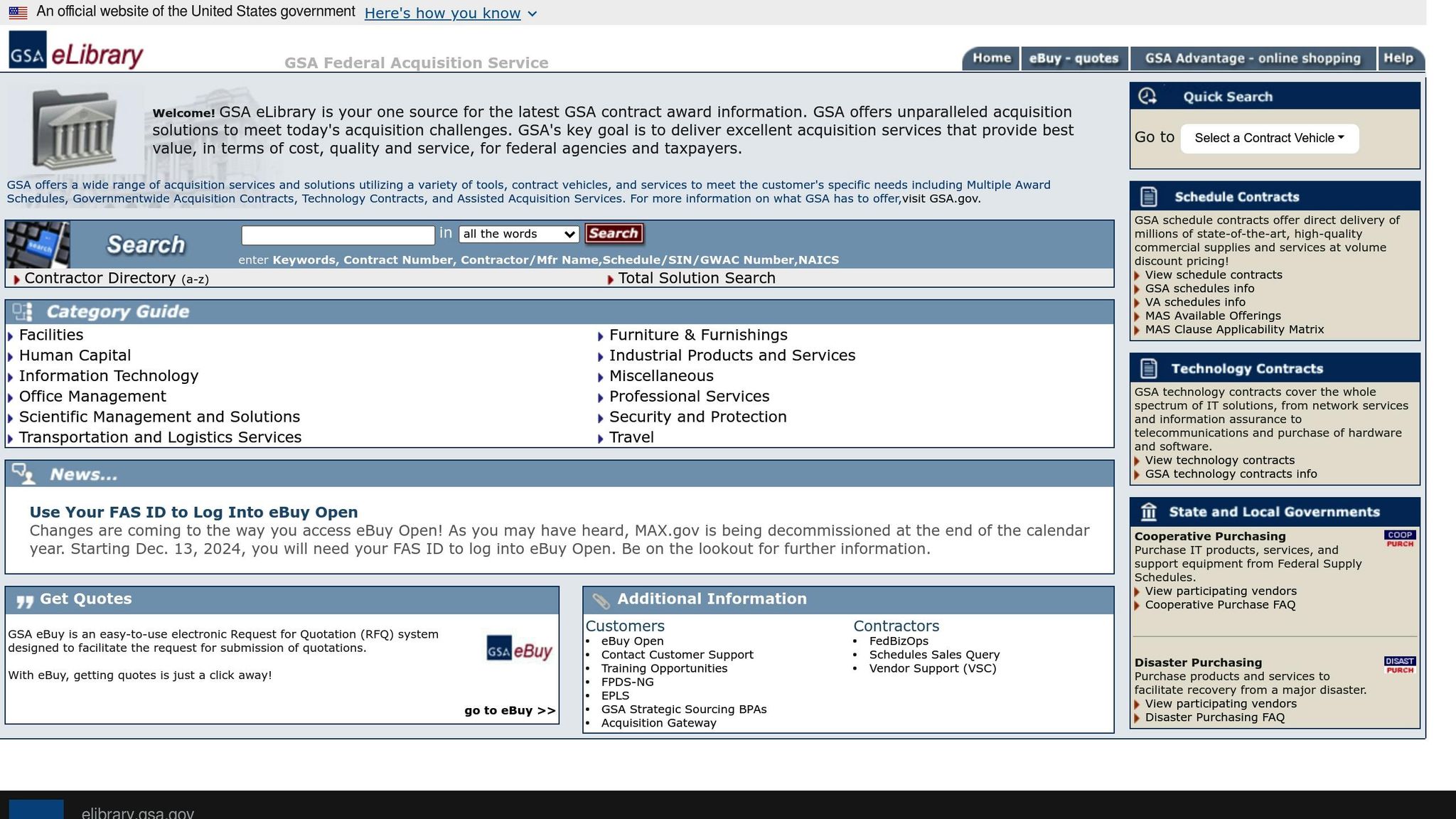A GSA Schedule Contract is your gateway to selling products or services directly to the U.S. government. With over $50 billion in annual spending through these contracts, it’s a huge opportunity – especially for small businesses, which received 37% of GSA sales in 2023. But the process can take 6–12 months, so preparation is key.
Here’s a quick overview of the six steps to secure your GSA contract:
- Check Your Eligibility: Ensure your business meets requirements like two years of operational history, Trade Agreements Act (TAA) compliance, and a track record of commercial sales.
- Register on SAM.gov: Create a Login.gov account, get your Unique Entity ID (UEI), and complete your free registration on SAM.gov.
- Choose Your SINs: Select Special Item Numbers (SINs) that align with your products or services using the GSA eLibrary.
- Prepare Documents: Compile administrative, technical, and pricing documents, including past performance records and a pricing proposal.
- Submit Your Proposal: Use the eOffer system to submit your application, ensuring all details are accurate and aligned.
- Market Your Contract: Once approved, list your offerings on GSA Advantage and eLibrary, and actively market to federal buyers.
Pro Tip: Only 15% of first-time applicants succeed. Double-check your documents, align pricing with federal standards, and consider professional help to avoid delays.
How To Apply For A GSA Contract? – CountyOffice.org
Step 1: Check Your Business Eligibility
Before starting your GSA contract application, make sure your business meets the key eligibility requirements. This involves reviewing your company’s credentials to confirm readiness for the process.
Business Size and Experience Requirements
To qualify for a GSA contract, your business generally needs at least two years of operational history. This isn’t just about having a business license – GSA looks for a proven track record of operations. However, IT companies with less than two years of experience may still qualify through the Springboard Program.
If your business is relatively new, you’ll need to show financial stability. This can be done by providing consistent and clear revenue documentation.
Compliance with TAA and Federal Regulations
Federal compliance is a critical component of eligibility. One key requirement is adherence to the Trade Agreements Act (TAA). Enacted in 1979, the TAA mandates that products sold to the U.S. government must be manufactured in the United States or in a designated country. Failure to comply can result in severe consequences, including contract termination, fines, and potential legal action.
To meet TAA requirements, at least 50% of your product’s value must come from the U.S. or approved countries. Proper documentation of your supply chain is essential, including detailed records of where all components and materials originate.
Here are some practical steps to ensure TAA compliance:
- Review your supply chain thoroughly to confirm component origins.
- Implement regular audits and maintain compliance checklists.
- Provide your team with ongoing training on TAA regulations.
- Seek advice from legal professionals when necessary.
Keep in mind that TAA compliance isn’t a one-time task – it’s an ongoing requirement throughout the duration of your contract.
Commercial Availability of Products or Services
Your products or services must already have a track record in the commercial marketplace to qualify for a GSA contract. This requirement ensures that your offerings have been tested in real-world conditions and that you’re equipped to handle large-scale orders.
To demonstrate this, you’ll need to provide documentation such as invoices and sales records that show a history of commercial sales. If you’re introducing new and untested products, focus on building a customer base in the commercial sector before pursuing federal opportunities. Meeting this criterion will make your GSA application process smoother and more efficient.
Step 2: Register on SAM.gov

After confirming your business eligibility, the next big step is registering on SAM.gov. This step is absolutely essential if you’re planning to pursue federal contracts, including GSA contracts.
What Is SAM.gov?
SAM.gov is the U.S. Government’s official platform for managing federal award processes. Operated by the General Services Administration (GSA), it acts as a one-stop system for businesses to register with the federal government, update their information, check their registration status, and access records related to registration and exclusions.
To bid on federal contracts or get paid for them, you must be registered on SAM.gov. This platform also assigns your business a Unique Entity ID (UEI) – a 12-character alphanumeric code that replaced the older DUNS number system for federal awards. And here’s some good news: there’s no fee to use SAM.gov.
SAM.gov has also absorbed the functions of older systems like FAPIIS.gov, FBO.gov, CFDA.gov, and WDOL.gov, making it a streamlined solution for federal contracting.
How to Complete Your Entity Registration
Now that you know what SAM.gov is, let’s talk about how to get your registration done right. It’s a detailed process, but with the right preparation, you’ll get through it smoothly.
1. Start with Login.gov credentials.
Before you can register on SAM.gov, you’ll need a Login.gov account. The person who will act as the Entity Administrator for your business should create this account, as they’ll be responsible for managing the registration.
2. Choose the right registration type.
On the SAM.gov homepage, click "Get Started" and select "Register Entity". You’ll then need to decide on the type of registration:
- If you only need a UEI for sub-award reporting, choose the "Get a Unique Entity ID" option. Keep in mind that this won’t allow you to apply directly for federal contracts.
- For bidding on federal contracts or applying for grants, select the "All Awards" or "Financial Assistance" registration type.
3. Plan for the timeline.
The registration process can take up to 10 business days to activate. Once you’ve submitted your application, you can track its status directly on SAM.gov.
4. Avoid common mistakes.
Pay extra attention to these areas to sidestep delays:
- Financial details: Double-check your bank’s ACH department contact information. Incorrect details can halt registration or delay payments.
- Documents: Ensure all required documents are complete, accurate, and signed. Missing or incorrect paperwork is a common issue.
- NAICS codes: Verify that your business’s NAICS codes accurately reflect your operations. You’ll also need to submit a notarized letter signed by an authorized representative within 60 days.
5. Keep your registration active.
Your SAM.gov registration needs to be renewed annually. Failing to renew it on time can lead to deactivation, which means you won’t be eligible to pursue federal contracts.
A Few Pro Tips
Attention to detail is the name of the game here. Cross-check everything – your business registration, bank account details, and SAM.gov information must all match up. To stay organized, consider creating a centralized digital file where your team can easily access all registration-related documents and confirmations.
Step 3: Choose Your SINs and Prepare Documents
Now that your SAM.gov registration is complete, it’s time to tackle a crucial step: selecting the right Special Item Numbers (SINs) and gathering all necessary documents. This part of the process demands precision because choosing the wrong SINs or submitting incomplete paperwork can throw a wrench in your entire application.
Find the Right SINs
Special Item Numbers (SINs) are alphanumeric codes used to classify products and services under the GSA Schedule Program. They help organize offerings within the federal marketplace, making it easier for government buyers to find what they need.
Here’s how the GSA Schedule is structured: it consists of 12 Large Categories, each representing a broad industry. These categories are further divided into subcategories, which then break down into 315 specific SINs. For instance, if your company sells pens, you’d likely fall under the Office Management Large Category, with the sequence: Subcategory: Office Supplies; SIN: 339940.
One thing to keep in mind: GSA can reject your SIN selection – or your entire proposal – if the SIN is deemed out of scope for your offerings. The key here is alignment. Carefully review the scope of each SIN to ensure it matches your company’s products or services.
To get started, head over to the GSA eLibrary, which provides detailed SIN descriptions and their associated scopes. This resource is invaluable for understanding how your offerings align with federal requirements. While your NAICS codes can serve as a starting point, always double-check the specific requirements of each SIN.
You’re not restricted to just one SIN. If your business spans multiple categories, you can list under several SINs, which can boost your visibility and opportunities for government contracts. However, accuracy is critical – only apply for SINs that genuinely reflect your capabilities.
Before finalizing your choices, visit the Available Offerings and Requirements page on SAM.gov to verify any additional document needs. Once your SINs are selected, you’re ready to gather the required documents.
Collect Required Documents
A GSA Schedule proposal includes three main sections: administrative, technical, and pricing. Each serves a specific purpose and requires different documentation.
1. Administrative Section
This section introduces your company and confirms compliance with federal regulations. You’ll need to submit basic business details, certifications, and evidence that your company meets federal contracting standards.
2. Technical Section
Here’s where you showcase your company’s experience and qualifications. The goal is to convince GSA that your business is equipped to handle government contracts. Your technical documentation should include:
- Corporate Experience Narrative: Highlight your company’s background, expertise, and past work. If you’ve worked with government agencies before, make sure to emphasize that.
- Quality Control Narrative: Explain the measures your company takes to deliver high-quality results. Be specific about who oversees quality control and the steps they follow.
- Past Performance Documentation: Provide references through Contractor Performance Assessment Reports (CPARs) or Past Performance Questionnaires (PPQs). These should demonstrate your reliability and the positive experiences others have had working with you.
- Past Project Narratives: If you’re offering services, include examples of previous projects that align with the type of work you’re proposing. Detail the outcomes, tools, and processes you used.
3. Pricing Section
This section outlines your products and services, along with your pricing strategy. Your pricing must be competitive and demonstrate value to the federal marketplace.
To stay organized, use the GSA offeror checklist, which summarizes the minimum submission requirements and includes category-specific tabs. This checklist can act as your guide to ensure you don’t overlook anything important.
When addressing technical requirements, clarity is essential. Avoid vague language and ensure your responses align perfectly with what the government is asking for. A well-prepared application significantly reduces the risk of rejection.
Since GSA contracts can last up to 20 years, the effort you invest in preparing thorough documentation now can yield long-term benefits. Regularly updating your documents will help maintain your standing and keep your business competitive. Once everything is ready, you’ll be set to submit your proposal.
Step 4: Set Pricing and Submit Through eOffer

With all your documentation in place, it’s time to focus on pricing and submitting your proposal. This step is crucial since your pricing strategy will directly impact your competitiveness and compliance with federal regulations. Let’s break it down.
Set Fair and Reasonable Pricing
The General Services Administration (GSA) defines "fair and reasonable pricing" as pricing that aligns with federal standards for value and competitiveness. Essentially, your prices should reflect what a savvy businessperson would consider acceptable in typical market conditions.
Understanding GSA’s Pricing Framework
GSA evaluates your pricing based on factors like labor, training, and the complexity of the services you’re offering. Here’s how it works:
- Supplies: These are listed at fixed prices.
- Services: These can be priced either at hourly rates or as fixed prices for specific tasks.
Conducting Market Research
To ensure your pricing is competitive, leverage tools like the GSA eLibrary and GSA Calc Tool. These resources help you compare your prices to similar goods or services already listed on GSA contracts. Pay special attention to regional pricing differences, as economic conditions and location can influence what is considered reasonable.
Avoiding Common Pricing Mistakes
Pricing missteps can derail your proposal. Here are some pitfalls to avoid:
- Using outdated pricing assumptions can lead to discrepancies during the review process.
- Inconsistencies between your invoices, commercial sales practices, and price proposal template can raise red flags.
- Overpricing might help you win the initial contract, but it could hurt your chances in future competitive bids.
Triple-check that your pricing, labor categories, and supporting documents are aligned. Accuracy is key.
Pricing Strategy Considerations
Your pricing should show that the government is getting the same or better deal than your most favored customer. This balance is critical to securing the contract and maintaining compliance.
Submit Your Proposal in eOffer
Once your pricing is finalized, it’s time to submit your proposal through the eOffer system. This platform handles the entire submission process, so attention to detail is essential.
Preparing for eOffer Submission
Before you start, gather all necessary company information and documents required for your specific solicitation. The eOffer process involves completing several sections and uploading your supporting materials, so staying organized is crucial.
Using eOffer
Here’s how to navigate the eOffer platform:
- Log in using your Unique Entity ID (which has replaced the old DUNS number system).
- Assign negotiators who can communicate with GSA on your behalf.
- Select your SINs, answer the required business-related questions, and carefully review all solicitation clauses – especially those tied to pricing and compliance.
- Upload all necessary documents with clear, descriptive file names. Double-check everything for consistency before hitting submit.
Post-Submission Process
After you submit, your offer will be reviewed by a GSA Contracting Official. During this evaluation, the contracting officer may request clarifications or additional details. Respond promptly to these inquiries to keep your application on track and avoid delays.
sbb-itb-8737801
Step 5: Handle Review Questions and Wait for Approval
After submitting your proposal through eOffer, your application enters a detailed review phase. This step is critical, as timely and effective responses to inquiries can keep the process on track. Below, we’ll cover how to address common review questions and navigate the approval timeline.
Common Review Questions
GSA Contracting Specialists and Officers carefully evaluate your proposal for accuracy, completeness, and adherence to federal guidelines. Every aspect is scrutinized to ensure your submission meets the required standards.
SIN Scope and Pricing Support
One frequent area of concern is your SIN (Special Item Number) scope and pricing support. If there’s a mismatch in your SIN alignment, it can stall the process and cause significant delays. To avoid this, double-check that your SINs align with the services or products you’re offering before submission.
Pricing and Documentation
Another common query involves pricing and supporting documentation. Be ready to provide:
- Recent invoices that reflect your commercial pricing.
- Market research showing competitive rates.
Keeping these records organized and readily accessible can save valuable time when responding to questions.
Review Timeline Expectations
Once you’ve addressed any review questions, it’s important to understand the typical timeline for approval. The GSA contract award process generally takes 6 to 12 months. This extended timeframe underscores the detailed nature of federal procurement.
Ways to Shorten the Timeline
For those looking to expedite the process, there are a few options:
- Experienced Consultants: Hiring professionals familiar with GSA procedures can help streamline your submission.
- GSA FASt Lane: If you’re in the IT sector, this program can cut the review time in half, potentially reducing it to 3 to 6 months.
- Letter to Expedite: A procuring contracting official can issue this letter, which may prioritize your proposal in the review queue.
Statistics show that about 60% of first-time offers are rejected due to documentation errors. Ensuring your offer is complete and clear from the start is the best way to avoid delays.
Building Professional Relationships
Maintaining open communication with your assigned Contracting Officer is key. Prompt and clear responses not only demonstrate professionalism but can also help move your application along more efficiently. A proactive relationship with your officer may even shorten the review period.
Step 6: Get Your Contract and Start Marketing
Securing your GSA contract is a big step forward, but it’s just the beginning. Now, the real work begins – making your business visible and building a solid federal sales pipeline.
"Becoming a GSA contract holder does not guarantee you’ll get any business. You still need to compete against other businesses for contracts or orders." – GSA
This quote serves as a reality check: the contract is a tool, not a guarantee. Success depends on how well you market your business and navigate the federal marketplace.
List on GSA eLibrary and Advantage

The first thing to do after getting your contract is to ensure your information is live on GSA’s online platforms. Federal buyers frequently use GSA eLibrary to find contractors, so keeping this updated is critical.
Get Your Profile Up and Running
You have 30 days after your contract award to upload your electronic contract data to GSA Advantage and register your MAS contract on the Vendor Support Center (VSC). The Contractor Start-up Kit on the VSC site will guide you through the process. If you already have an MAS contract, make sure your VSC user profile is updated.
"As an MAS contractor, your firm will be listed in GSA eLibrary, our online source for the latest contract award information. After you upload your catalog to GSA Advantage (products) or eLibrary (services), your product and services offerings will be available through these tools." – GSA
Your GSA Advantage listing acts as your key online catalog for federal buyers. To stand out, include detailed product descriptions, high-quality photos, and GSA-approved pricing. Remember, 82% of federal decision-makers rely on corporate websites as a top research tool.
Take a Proactive Approach
Don’t just wait for buyers to find you – actively promote your listing. Share your eLibrary link with procurement officers and potential clients. For instance, Dig Defence, LLC, a fencing solutions company, saw increased visibility and expanded their network with prime contractors after securing their GSA Schedule listing in February 2025. Once your listing is live, shift your focus to staying compliant and tracking your sales to maximize the benefits of your contract.
Stay Compliant and Track Sales
Once you’ve established a presence in the federal marketplace, the next step is maintaining compliance and keeping track of your sales. These are essential for sustaining long-term success.
Understanding Sales Reporting
All MAS sales must be reported through the FAS Sales Reporting Portal (SRP). To get started, register for a FAS ID and familiarize yourself with the reporting requirements. MAS contractors report their sales monthly under the Transactional Data Reporting (TDR) program and quarterly under the traditional Schedule program.
Keep an eye on your sales by SIN (Special Item Number). Currently, the Industrial Funding Fee (IFF) rate is 0.75% for GSA’s Multiple Award Schedule, unless otherwise specified. This fee helps fund the Federal Supply Schedules Program.
Meeting Sales Minimums and Staying on Track
Your contract has specific sales targets: $100,000 in the first five years and $125,000 for each subsequent five-year period. Hitting these numbers is critical for contract renewal.
GSA assigns an Industrial Operations Analyst (IOA) to assist you with compliance, but the responsibility ultimately lies with you.
"A GSA representative (known as an industrial operations analyst) assigned to you after award will work with you during the contract term to help you remain compliant."
Make sure to keep your SAM.gov profile updated annually and refresh your information in the Federal Awardee Performance and Integrity Information System (FAPIIS) every six months.
Develop a Federal Marketing Plan
Federal procurement spending for Fiscal Year 2024 is estimated to range between $762 billion and $870 billion, offering plenty of opportunities. However, marketing to government agencies requires a specialized approach.
Train your sales, marketing, and accounting teams on the ins and outs of your GSA contract. Dedicate a section of your website to government customers, showcasing your contract details, past performance, case studies, and capabilities statements. Research target agencies to understand their budgets, acquisition plans, and past contracts.
"Government agencies work with people and organizations they know, like, and trust. A consistent marketing presence helps build your credibility and build brand trust." – Ocean 5 Strategies
Additionally, keep an eye on contracting opportunities through GSA eBuy and SAM.gov. Attend industry days and federal contracting events to grow your network and strengthen your brand. Consistency in your messaging and outreach helps build the trust needed to thrive in the federal marketplace.
Your GSA contract opens doors, but your success will depend on how well you market your capabilities and maintain compliance with federal requirements.
Conclusion
Securing a GSA contract offers substantial opportunities for businesses aiming to work with the federal government. The six-step process – verifying eligibility, registering on SAM.gov, selecting SINs and compiling necessary documents, setting competitive pricing and submitting via eOffer, addressing review questions, and marketing your contract – serves as a clear pathway to entering this lucrative marketplace.
To put things into perspective, GSA MAS sales exceeded $40 billion last fiscal year, and in fiscal year 2023, GSA contracts accounted for over $50 billion in government spending. As Federal Schedules, Inc. aptly puts it:
"The GSA Multiple Award Schedule (MAS) Contract is the most widely used government contract." – Federal Schedules, Inc.
However, the process is not without its hurdles. On average, it takes 6 to 12 months to secure a GSA contract award. This makes attention to detail and error-free documentation absolutely essential.
For businesses looking to streamline this timeline, expert assistance can make a significant difference. Consultants with experience in GSA requirements can cut the application timeline by 30% to 50%. Yet, the reality remains that only about 15% of the 10,000 companies applying annually secure approval on their first try. This underscores the importance of meticulous preparation.
To maximize your chances of success, ensure that your application is complete and accurate from the start. Research market rates thoroughly to set competitive pricing and consider enlisting professional help to navigate the complexities of GSA requirements. Such preparation can help you avoid common mistakes that could delay or derail your application.
A GSA contract is much more than a piece of paper – it’s a gateway to federal opportunities. By approaching the process with diligence and leveraging the right resources, you can position your business among the many contractors thriving in this dynamic marketplace. The journey may be challenging, but with the right strategy, the rewards are well worth the effort.
FAQs
What are the most common mistakes when applying for a GSA contract, and how can you avoid them?
Common Mistakes When Applying for a GSA Contract
Applying for a GSA contract can be a complex process, and certain missteps can cause unnecessary delays or even rejection. One of the most common mistakes is submitting incomplete or incorrect documentation. This might include missing financial records or poorly written technical narratives that fail to meet the required standards. These errors can slow down the approval process significantly.
Another frequent issue involves misunderstanding GSA pricing requirements. For instance, some applicants fail to offer pricing that’s considered fair and reasonable or neglect to comply with the Most Favored Customer clause, which ensures the government gets pricing comparable to or better than your most preferred clients.
How to Avoid These Mistakes
- Double-check your documentation: Review all your application materials to ensure they are accurate, complete, and meet GSA standards.
- Understand pricing guidelines: Make sure your pricing aligns with GSA expectations and adheres to federal rules.
- Seek professional help if needed: If you’re unsure about any part of the process, consider consulting with experts or attending vendor training programs. This can help you navigate the requirements and submit a strong proposal.
Taking the time to prepare thoroughly can save you from headaches down the road and improve your chances of securing a GSA contract.
What steps can small businesses take to improve their chances of getting a GSA contract on their first try?
Small businesses aiming to secure a GSA contract should start by thoroughly understanding the federal marketplace and the steps involved in the GSA contract process. This means diving into the requirements, pinpointing the most relevant Schedule categories for your services or products, and confirming that your business meets all the necessary eligibility standards.
Preparation is everything. Focus on crafting a well-thought-out technical proposal, double-checking that all required documents are complete and compliant, and setting competitive pricing that aligns with GSA expectations. During the review process, clear and prompt communication is crucial – it reflects professionalism and shows you’re ready to meet federal standards. Once you’ve secured the contract, don’t stop there. Actively promote your GSA contract, connect with federal buyers, and position your business to make the most of the opportunities available.
What are the best ways to promote your GSA contract to federal buyers after it’s awarded?
To successfully market your GSA contract to federal buyers, begin with a focused federal sales strategy that aligns with the needs of your target agencies. Leverage platforms like GSA Advantage! to display your products or services and ensure your contract information is always accurate and current in the GSA eLibrary.
Strengthen your presence by attending government procurement events, connecting with agency representatives, and responding quickly to any inquiries. A polished online presence is equally important – highlight your GSA contract and clearly communicate how it benefits potential buyers. Building strong relationships and staying visible through consistent outreach will help you make meaningful connections with federal customers.
Related posts
- How to Set GSA Prices for Federal Contracts
- How to Access GSA Small Business Support Programs
- 5 Steps to Meet GSA Prequalification Standards
- Selling Services via GSA Schedule: A Complete Walkthrough


